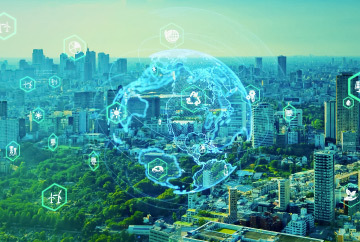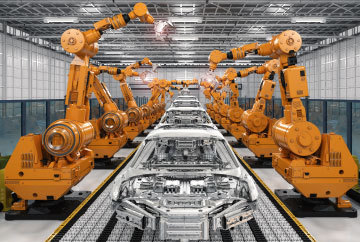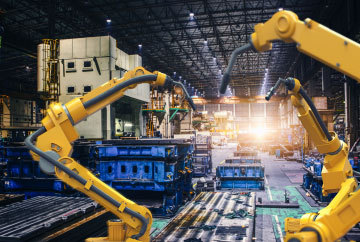The manufacturing sector has always accounted for a significant chunk of global CO2 emissions, which have grown multifold in today's market. First off, the processes followed by the manufacturing industries heavily rely on natural resources and fossil fuels. Secondly, carbon intensity across the value chain increases the risk factor for industrial manufacturing operations.
Green Manufacturing: Solving the Rubik’s Cube
Recent announcements by GAFA and the like have demonstrated the importance of carbon footprints for businesses. Apple, for instance, has committed to making its supply chain carbon-neutral by as early as 2030. But that's just one of the many drivers of decarbonization. In addition, the public perception of using low-carbon product branding, raising energy efficiency standards, and lowering trade barriers by boosting demand for carbon-neutral products stimulates its demand.
According to a 2020 report, Carbon emissions are responsible for about 79% of all GHG emissions in the US, for which the manufacturing industry is significantly responsible. The 2015 Paris Agreement set goals to limit global warming to under two °C above previously established industry levels and pursue net carbon neutrality by 2050. Decarbonization is about reaching zero emissions by shifting from fossil fuels to alternative low-carbon energy sources, which has become a global imperative for governments and organizations. To that end, the SEC is a publicly mandated organization to monitor and report their CO2 emissions and reduce them as classified in the three established scopes. They have also proposed auditing all the climate-related information written by the organization by a registered public accounting firm.
Decrypting Direct and Indirect Emissions
GHG Protocol corporate standards classify a company's greenhouse gas emissions into three scopes. While the first two scopes are mandatory to report, the third is voluntary, as it's the most difficult to monitor. Yet, companies reporting all three will undoubtedly have a competitive advantage in sustainability.
Scope 1: Direct Emissions
These are emissions from company-owned and controlled resources, including stationary combustion from fuels, mobile combustion from traditional vehicles, fugitive emissions such as refrigerant gas leaks, and process emissions from on-site manufacturing.
Scope 2: Indirect Emissions - Owned
These are indirect emissions from purchased steam, cooling, heating, and electricity consumption. Using all-electric vehicles, PHEVs fall under this category as these have no tailpipe emissions. Nonetheless, electrical power sources like power plants generate emissions that must be checked.
Scope 3: Indirect Emissions - Not Owned
Scope 3 emissions are those indirect emissions not included in scope 2. They are scattered across the company's value chain. For example, activities such as air travel for business, waste generated and sent to landfills, transportation, and distribution, emissions from the company's franchises, etc., are all part of scope three emissions. While most businesses have primarily targeted their efforts in measuring and reducing emissions from their electricity consumption and operations, scope 3 emissions are the most significant across the industry.
The Scope 3 Standard offers a systematic approach to assessing and managing emissions from all sources and can help companies calculate their carbon footprint more accurately. Even the Greenhouse Gas (GHG) Protocol is developing guidelines on how organizations can account for greenhouse gas emissions and carbon removals from bioenergy, land use, etc. They offer GHG accounting standards, learning material for these standards to create general awareness, and tools to help companies develop reliable inventories of their GHG emissions.
Is Managing Carbon Footprint Optional
Apparently not. The Energy Innovation and Carbon Dividend Act of 2021 has laid out explicit mandates for the manufacturing industry that will help reduce the US's carbon pollution by 50% by as early as 2030 and reach net zero by 2050. Moreover, the International Monetary Fund (IMF) has proposed to set up an international carbon price floor to help limit global warming and help transition towards low carbon growth over this decade.
Every manufacturing company must develop or adopt a solution that reduces its carbon footprint and sets it on a path to becoming genuinely sustainable. For that purpose, they must gather all the relevant data and determine the source of their footprint. Only when the first two steps are complete can they take actions to reduce the emissions and offset them across their entire infrastructure and become carbon-neutral.
Corporations are under immense pressure from their stakeholders to meet the new environmental, social, and governance (ESG) standards, and meeting the various regulations has become increasingly challenging. As a result, carbon taxes are now being implemented worldwide in different countries to compensate for the excess GHG emissions. There are 27 such countries globally, of which Denmark’s corporate carbon tax is the highest in Europe. It is on the path to cutting GHG emissions by 70% from 1990 levels by 2030.
In the USA, the Energy Innovation and Carbon Dividend Act has imposed a carbon fee, too, that starts at $15 per metric ton of C02 equivalent emissions. Moreover, the America Wins Act of May 18, 2021, imposes an excise on the CO2 content in fossil fuels sold by an importer, producer, or manufacturer. Even the IMF has proposed to set up an international carbon price floor with prices ranging between $25-75 per ton of carbon emissions for low- and high-income countries, respectively.
Challenges in Adopting Decarbonization
Decarbonization is more of a business problem than a digital one. While businesses have indeed started taking concrete measures toward a more sustainable future, digital solutions can catalyze their initiatives and promote climate protection and biodiversity preservation.
Numerous challenges come with taking the initiative to reduce an organization's carbon footprint. For instance, measuring emissions under scope 3, even the promising carbon capturing solution, feels infeasible both technologically and economically. Moreover, using carbon reduction levers like green/renewable energy (solar and wind energy, etc.), while ideal, are economically crippling and even begs the question of technical feasibility for all organizations across industries. The data for measuring all of this may be from multiple systems that may or may not be interoperable today; it had to be gathered across various time stamps and consolidated with permutations and combinations that give the right picture in line with the goals companies have set.

How Adopting Digital Can Help
Digitalization has the potential to fundamentally change our ecological present, including the way we consume information, our lifestyles, economic activities, transportation, and whatnot. It's not about using a few unique technologies but the effect that stems from their ever-changing interaction. Moreover, with its rapid development, digitalization has begun to support the demand for energy and other valuable resources.
Digital can play a critical role in catalyzing this solution as well as helping to measure, baseline, and improve this score across the value chain, which starts with first bringing all the data together and then bringing it to one set of centralized dashboards, providing data visibility to various parties across and outside the organization. This helps all to see hidden carbon hotspots in the value chain and enables setting the right targets for reduction using various Industry 4.0 technologies such as :
AI-enabled Intelligent Operations
Enterprises can use Artificial Intelligence to improve plastic recycling numbers, which can reduce waste in the food industry by improving the quality control process and forecasting consumer demand with higher accuracy.
Carbon Score Dashboards
Data visualization is a core digital innovation that helps companies get in-depth insights into their carbon footprint, as it delivers intelligible insights from day-to-day business operations. These dashboards collect data from all interoperable systems, compare it to pre-established benchmarks and provide easy-to-consume narratives and forecasts.
Blockchain for tracking Carbon Footprint
Blockchain technology has revolutionized the way we imagine currency and has a lot of other applications that can help reduce a company's carbon footprint. For instance, blockchain can make manufacturer data more reliable and forgery-proof.
Packaging 4.0
Packaging 4.0 is an intelligent method of adopting eco-friendly packaging well-integrated with the vision of Industry 4.0. It optimizes supply chains and ensures the conservation of resources through waste tracking and reduces wastage during production, be it of the packaging or the product itself.
While adopting digital technologies is no longer an option for going carbon neutral, managing these innovative technologies is quite complex and requires advanced data collection and interdisciplinary cooperation. In addition, interoperability is vital for data centers where resources are pooled, which may be challenging. Another major hurdle in adopting digital sustainability is the required scale for real-time data harvesting. Data centers are the source of a significant chunk of worldwide energy consumption of digitization, and developing more sustainable data centers is the next step toward decarbonization.
Final Thoughts
Technology and regulations must go hand-in-hand to deliver the much-needed momentum to the decarbonization drive. Gathering data, assessing, calculating, managing, and reporting carbon emissions is not a walk in the park, let alone for these manufacturing firms. By adopting modern digital technologies, which are more like lego pieces, organizations can begin to create the model for a green future, amalgamating this with the technical knowledge and operational excellence required to set industry-wide baselines, assess their carbon footprint, and finally find actionable insights to reduce it and drive this green transformation - one step at a time.
More from this Author
Recommended
Manufacturing | 9 Min Read



